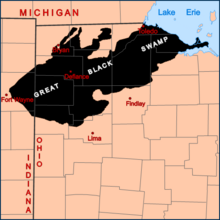
Back Great Black Swamp German Great Black Swamp Finnish Grande palude nera Italian Grande Pântano Negro Portuguese

The ridge was formed at the southern shore of the ancient lake. In the distance, a completely flat expanse of agricultural land extends to the horizon. In the foreground a ditch used to drain the swamp is visible.[1][2]

The Great Black Swamp (also known simply as the Black Swamp) was a glacially fed wetland in northwest Ohio and northeast Indiana, United States, that existed from the end of the Wisconsin glaciation until the late 19th century. Comprising extensive swamps and marshes, with some higher, drier ground interspersed, it occupied what was formerly the southwestern part of proglacial Lake Maumee, a Holocene precursor to Lake Erie. The area was about 25 miles (40 km) wide (north to south) and 100 miles (160 km) long, covering an estimated 1,500 square miles (4,000 km2).[3] Gradually drained and settled in the second half of the 19th century, it is now highly productive farmland. However, this development has been detrimental to the ecosystem as a result of agricultural runoff.[4] This runoff, in turn, has contributed to frequent toxic algal blooms in Lake Erie.[5]
The land once covered by the swamp lies primarily within the Maumee River and Portage River watersheds in northwest Ohio and northeast Indiana. The boundary was determined primarily by ancient sandy beach ridges formed on the shores of Lakes Maumee and Whittlesey, after glacial retreat several thousand years ago. It stretched roughly from Fort Wayne, Indiana, eastward to the Ottawa National Wildlife Refuge near Port Clinton along the Lake Erie shore, and from (roughly) US 6 south to Findlay[6] and North Star, Ohio in Darke County.[7] Near its southern edge at the southwestern corner of present-day Auglaize County, wheeled transportation was impossible during most of the year, and local residents thought the rigors of travel to be unsuitable for anyone except adult men.[8]
The vast swamp was a network of forests, wetlands, and grasslands. In the lowest, flattest areas, prone to permanent inundation, deciduous swamp forests predominated, characterized especially by species of ash, elm, cottonwood and sycamore. In slightly higher areas with some topographic relief and better drainage, beech, maples, basswood, tuliptree and other more mesic species were dominant. On elevated beach ridges and moraines with good to excessive drainage, more xeric species, especially oak and hickory, were dominant. The area contained non-forested wetlands, particularly marsh and wet prairies, with marshes being particularly extensive along the Lake Erie shoreline east of Toledo.
- ^ "The Great Black Swamp..." Welcome to Historic Perrysburg. Archived from the original on February 18, 2007. Retrieved January 22, 2012.
- ^ Kaycee Hallett (April 14, 2011). "History of the Great Black Swamp". The Black Swamp Journal. Retrieved January 22, 2012.
- ^ Mitsch, William J.; James G. Gosselink (2007). Wetlands. John Wiley & Sons. pp. 65–66. ISBN 978-0-471-69967-5.
- ^ Hallett, Kaycee (April 14, 2014). "History of the Black Swamp". The Black Swamp Journal. Retrieved December 3, 2019.
- ^ Dybas, Cheryl (April 8, 2019). "Lake Erie's toxic algae blooms: Why is the water turning green?". National Science Foundation. Retrieved December 3, 2019.
- ^ The Great Black Swamp Archived January 17, 2010, at the Wayback Machine, Black Swamp Conservancy
- ^ Brown, Mary Ann. Ohio Historic Inventory Nomination: St. Louis Catholic Church. Ohio Historical Society, April 1977.
- ^ McMurray, William J., ed. History of Auglaize County Ohio. Vol. 1. Indianapolis: Historical Publishing Company, 1923, 335.
© MMXXIII Rich X Search. We shall prevail. All rights reserved. Rich X Search